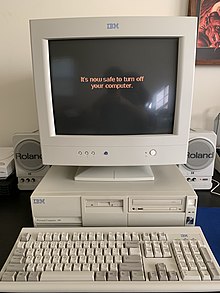IBM PC Series
The IBM PC Series personal computer was the follow-on to the IBM PS/ValuePoint and IBM Personal System/2. Announced in October 1994 and withdrawn in October 2000, it was replaced by the IBM NetVista, apart from the Pentium Pro-based PC360 and PC365, which were replaced by the IBM IntelliStation.
PC 100
The PC 100 was a budget model, available only in selected markets.
PC 140
The PC 140 was a budget model, available only in selected markets.
PC Series 300
Industry standard ISA/PCI architecture, first IBM machines with USB. Processors ranged from the 486DX2-50, 486SX-25, 486DX4-100 to the Pentium 200 and in case of the Models 360 and 365 the Pentium Pro. 486 models had a selectable bus architecture (SelectaBus) through a replaceable riser-card, offering the choice of either VESA Local Bus/ISA or PCI/ISA. Within the 300 series the following models appeared:
PC 330
.jpg)
Its last sub model used the Pentium P54C processor clocked at 100, 133 or 166 MHz. It had, depending on the sub-model, up to 4 ISA and/or 3 PCI expansion slots and four (2 external 5.25 inch, 1 external and 1 internal 3.5 inch) drive bays. It had in its latest version, the 6577, 1 DIMM-168 and 4 SIMM-72 RAM slots, and featured an IBM SurePath BIOS. This PC has 2 USB 1.0 slots in the back. The latest operating system which can be installed in this PC is Windows 2000 or Windows ME. Windows XP can also be installed, but performance drops to unusable levels.
It comes with a 5 volt SDRAM slot which is incompatible with the 3.3V (the more commonly used SDRAM). The slot looks the same at first glance, but the keying is different. Trying to force a 3.3V SDRAM module into the 5V SDRAM slot could damage the slot and memory chips.
Submodels were:
| Name | Model | CPU | MHz | Remarks |
|---|---|---|---|---|
| IBM Personal Computer 330 | Model 6571-Kxx, Lxx, Wxx | Intel 486 | 25-100 | OPTi chipset; shipped with ISA/VLB raiser card |
| IBM Personal Computer 330 | Model 6573-Kxx, Lxx, Wxx | Intel 486 | 25-100 | OPTi chipset; shipped with ISA/PCI raiser card |
| IBM Personal Computer 330 | Model 6575-1xx | Intel Pentium P5 | 60-66 | up to 133 MHz using the Pentium overdrive |
| IBM Personal Computer 330 | Model 6576-3xx, 4xx, 5xx, 7xx, 9xx | Intel Pentium P54C | 75-100 | up to 200 MHz using the Pentium overdrive |
| IBM Personal Computer 330 | Model 6577-5xx, 7xx, 9xx, Gxx, Kxx, Lxx | Intel Pentium P54C | 75-166 | up to 233 MHz using the Pentium 233 MMX with 75 MHz settings |
PC 340

The PC 340, introduced in 1996,[1] was a budget model. It used the Pentium processor clocked at 100, 133 or 166 MHz. It had 4 ISA and 3 PCI expansion slots and four (2 external 5.25 inch, 1 external and 1 internal 3.5 inch) drive bays. It also had 4 SIMM-72 RAM slots, and featured an IBM SurePath BIOS. The submodels were:
- PC 300 Series Model 340 (Model 6560-1xx)
- PC 300 Series Model 340 (Model 6560-4xx)
- PC 300 Series Model 340 (Model 6560-5xx)
- PC 300 Series Model 340 (Model 6560-6xx)
- PC 300 Series Model 340 (Model 6560-7xx)
PC 350
The PC 350, introduced over 1994 to 1995,[1] was a middle-class model, having the same motherboard as the PC 330 in a much roomier case with additional drive bays. Processors ranged from the 486DX2-50, 486SX-25, 486DX4-100 to the Pentium 200. It had, depending on the sub-model up to 5 ISA and/or 3 PCI expansion slots and five (2 external 5.25 inch, 1 external and 1 internal 3.5 inch) drive bays. It had in its last version, just like the 330, 1 DIMM-168 and 4 SIMM-72 RAM slots, and featured an IBM SurePath BIOS.
Submodels were:
| Name | Model | CPU | MHz | Remarks |
|---|---|---|---|---|
| IBM Personal Computer 350 | Model 6581-Kxx, Lxx, Wxx | Intel 486 | 25-100 | OPTi chipset; shipped with ISA/VLB raiser card |
| IBM Personal Computer 350 | Model 6583-Kxx, Lxx, Wxx | Intel 486 | 25-100 | OPTi chipset; shipped with ISA/PCI raiser card |
| IBM Personal Computer 350 | Model 6585-1xx | Intel Pentium P5 | 60-66 | up to 133 MHz using the Pentium overdrive |
| IBM Personal Computer 350 | Model 6586-3xx, 4xx, 5xx, 7xx, 9xx | Intel Pentium P54C | 75-100 | |
| IBM Personal Computer 350 | Model 6587-5xx, 7xx, 9xx, Gxx, Kxx, Lxx | Intel Pentium P54C | 75-200 | up to 192 Mb RAM, CPU up to 233 MHz using a Pentium 233 MMX with 75 MHz settings. |
PC 360
The PC 360 was an ISA/PCI-based system with six expansion slots that uses the Pentium Pro CPU clocked at 150 or 200 MHz. It is packaged in a mini-tower with six drive bays. It had 4 SIMM-72 slots for a total of up to 128 Mb of memory, and featured an IBM SurePath BIOS. The submodels were:
- PC 360 Series Model 360 S150 (Model 6598-Cxx)
- PC 360 Series Model 360 S200 (Model 6598-Fxx)
PC 365
The PC 365 is an ISA/PCI-based multiprocessor system with five-expansion slots. It supports dual Pentium Pro processors clocked at 180 or 200 MHz. The case has five drive bays and either two ISA or PCI slots, plus an additional three of which are shared ISA/PCI slots. It had 4 DIMM-168 slots for a total of up to 512 Mb of memory, and featured an IBM SurePath BIOS. The submodels were:
- PC 365 Series Model 360 S180 (Model 6589-10U, 11U, 17U)
- PC 365 Series Model 360 S200 (Model 6589-12U, 13U, 15U, 18U)
PC Series 700
These systems used the Intel Pentium processor with clock frequencies of 75, 90, 100, 133 and 166 MHz. Initial systems had selectable bus architecture (SelectaBus) through a replaceable riser-card. Options were either PCI/ISA or PCI/MCA. The ISA or MCA bus would be connected to the PCI bus using a PCI to ISA/MCA bridge. The advantage of this is that even operating systems without MCA support worked on the system, as long as the MCA portion was not required.
Two form-factors were available, the 3x3 (3 slot, 3 bay) PC 730 and the larger 5x5 (5 slot, 5 bay) PC 750.
PC Power Series
This is the PC counterpart of the RS/6000
- PowerPC 604 processor at 100, 120 or 133 MHz
- ISA/PCI PReP architecture
- 16MB parity memory standard, expandable to 192MB
- Integrated 10baseT Ethernet, PCI Graphics and Audio
- Supports Windows NT 3.51 or AIX Version 4
- ARC BIOS
Two form-factors were available, the 3x3 (3 slot, 3 bay) PC830 and the larger 5x5 (5 slot, 5 bay) PC850.
| Name | Model | CPU | MHz | RS/6000 counterpart |
|---|---|---|---|---|
| Personal Computer Power Series 440[2] | 6015 | PowerPC 601 | 66 | Model 7020 (40P) |
| Personal Computer Power Series 830[3] | 6050 | PowerPC 604 | 100/120/133 | Model 7248 (43P) |
| Personal Computer Power Series 850 | 6070 | PowerPC 604 | 100/120/133 | Model 7248 (43P) |
PC Series 3000
This series was introduced in April 1996 in Canada only. It has a Pentium processor clocked at speeds ranging from 100 to 166 MHz and was shipped with a Mwave modem/sound card.
PC 300PL

The 300PL used three models of processors during its lifetime, the Pentium MMX, Pentium II and Pentium III. Models using the Pentium MMX came in speeds of 166, 200 and 233 MHz; models using the Pentium II came in speeds of 266, 300, 333, 350, 400 and 450 MHz; and models using the Pentium III came in speeds of 450, 500, 533, 550, 600, 667, 733, 800 and 866 MHz. The 300PL usually shipped with a hard drive with a capacity ranging from 2 GB to 20 GB, a CD-ROM drive, and a floppy drive. In some models, an IBM EtherJet 10/100 Ethernet network adapter is also included. The IBM 300PL came either in a tower or a desktop form-factor.
Four different types of form-factors exist:
- Three PCI slots, no AGP; it also has an extra bay for a CD or DVD drive (desktop)
- Three PCI slots and one AGP; it also an extra bay for a CD or DVD drive (desktop)
- Four PCI slots and one AGP; it also has an extra bay for a CD or DVD drive (desktop)
- Six PCI slots and one AGP; it also has two extra bays for a CD or DVD drive (tower)
PC 300GL
The PC 300GL used the Celeron, Pentium I, Pentium II and Pentium III throughout its lifetime. Celeron-based models had processors clocked at 333, 366, 433, 466, 500 and 533 MHz; Pentium I models had processors clocked at 133, and 166 MHz; Pentium II-based models had processors clocked at 350, 400, 450 MHz; and Pentium III-based models had processors clocked at 450, 500, 533, 550, 600, 667, 733, 800 and 866 MHz.
These systems were packaged in two case form-factors, desktop and micro-tower. There were two variants of the desktop case, one with two expansion slots and one with four. Both variants had four drive bays. The micro-tower case had four expansion slots and four drive bays.
PC 300XL
The PC 300XL uses the Pentium MMX clocked at 233 or 266 MHz, or the Pentium II clocked at 233, 266 or 300 MHz.[4] It features integrated 10/100 Ethernet.
See also
- IBM IntelliStation
- IBM NetVista
- IBM PS/2
- IBM PS/ValuePoint
- IBM PC XT
- IBM PC AT
- IBM System AIX for the IBM PC Server Series
References
- "Personal Systems Reference IBM PC 1994 to 2000 - withdrawn" (PDF). November 2000. p. 13. Retrieved 2018-02-06.
- "IBM Power Series 440 (6015), RISC/6000 (7020) Hardware Maintenance Manual" (PDF).
- "Hardware Withdrawal: IBM Power Series Products -- Replacements Available".
- "PC 300XL (Type 6588) and IntelliStation M Pro (Type 6888) Technical Information Manual" (PDF).
| Preceded by IBM PS/ValuePoint |
IBM Personal Computers | Succeeded by IBM IntelliStation IBM NetVista |